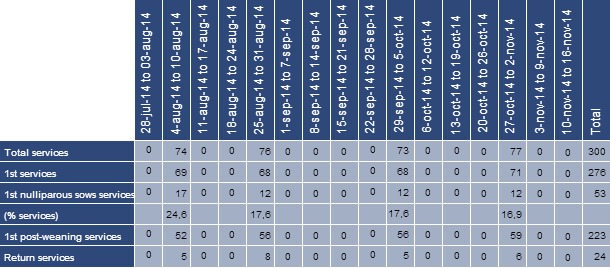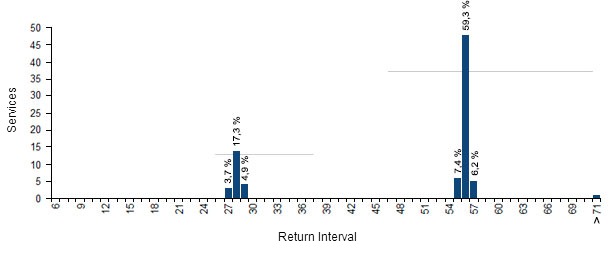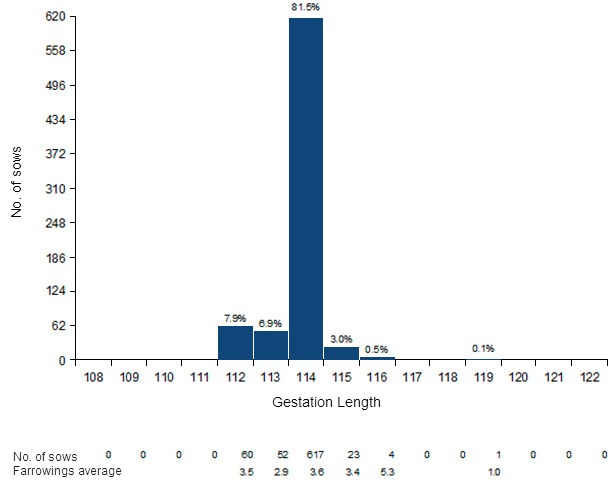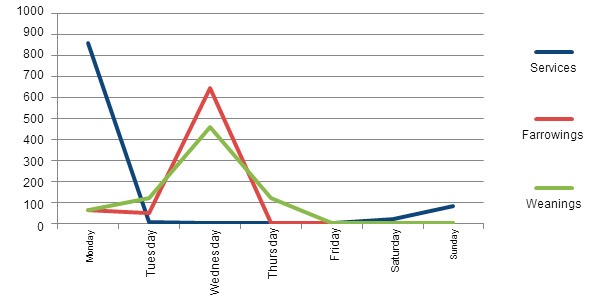The use of hormone based products, or homologues that perform the same function, has long become widespread in sows. The key objectives of the use of these products are scheduling events related to the sows (e.g. heat or farrow scheduling on a particular date), or causing physiological states in the sows that are not capable of causing them themselves (e.g. oestrus induction in anoestrus sows).
Next, a case of intensive use of hormones is shown in a small farm (325 productive sows) working on a 4-week batch system, with a consequent average lactation length of 21 days.

Oestrus synchronization
Nulliparous sows are already given hormones. As mentioned before, services in the farm happen every four weeks. The following table shows how all nulliparous sows are grouped to be serviced within the mating week; none of them is inseminated outside those periods, and the number achieved is always very similar.
Table 1. Services per week —16 week period.

In addition, this same table shows how not only nulliparae, but also the rest of the sows in the farm (weaned, returns) are always serviced within the mating week, so that batches are strictly maintained. In other words, all oestruses (weaned sows and returns) are scheduled to take place in such weeks. Returns are distributed as follows:
Graph 1. Returns distribution per return interval —one year period.

The figure shows how returns are grouped into two intervals, around 28 and 56 days, coinciding with one or two batches after the service. In this case, the acyclic returns between 27 and 30 days are serviced directly, while the rest of returns (cyclic 1, cyclic 2 and late cyclic) are not serviced, but synchronized with hormones to come into heat about 56 days after the service.
As per weaned sows, the following table shows the distribution of their weaning-to-1st service interval.
Table 2. Distribution of a weaning-to-1st service interval —one year period.
| Weaning-to-1st service interval | |||||||||
| 0-3 | 4 | 5 | 6 | 7 | 8-14 | 15-21 | 22+ | Total | |
| 1st services | 24 | 93 | 436 | 158 | 0 | 0 | 0 | 5 | 716 |
| % serviced | 3.4% | 13.0% | 60.9% | 22.1% | 0.0% | 0.0% | 0.0% | 0.7% | 100% |
| Weaning-to-service interval | 2.8 | 4.0 | 5.0 | 6.0 | 61.6 | 5.4 | |||

Most notable in this case is that there are no late services; virtually 100% of sows are serviced before the 7th day post-weaning. In this case, the sows are "forced" to come into heat again by using hormones; they are probably using next generation hormones both in gilts and in multiparous sows, since all services are on the same day. By applying these hormones after weaning, ovulation is induced, and heat synchronized in all sows.
As we have seen so far, the farm controls and perfectly synchronises all its sows heats, thus maintaining strict service batches.
Farrowing synchronization
The graph below shows how tasks in the farrowing rooms —in this case the farrowing itself—, are also strictly programmed. This is the farm's Gestation Length Histogram.
Graph 2. Gestation Length Histogram —one year period.

The average length is low, 113.8 days, and the distribution clearly shows how the farm synchronises all its sows' farrowing (except for the early farrowing cases) on day 114 of gestation.
Why synchronize? First part
Even though hormones are used in most farms, it is very unusual for them to do it at such an intensive level. Since the use of these products has a cost and implies increased management tasks compared to other more "natural" systems, we could ask ourselves the following questions: Why did we choose this management system in this farm? Or why, for example, is farrowing scheduled so soon?
The following chart explains the rationale for this operation very well. This graph shows the distribution, by day of the week, of the main tasks in the farm (service, farrowing and weaning).
Graph 3. Task distribution by day of the week —one year period.

It clearly shows that the main tasks are carried out between Monday and Wednesday, there being practically no important events from Thursday to Sunday:
- Services, regardless of the weaning day, are scheduled to happen always on a Monday (in fact, the few services that happened on a Sunday were also scheduled like that). This way, all sows are inseminated during the first days of the week.
- Since services are on Mondays, farrowings are scheduled to 114 days, to fall on a Wednesday. This way, Wednesdays are dedicated to attending sows at farrowing, and the first days of the piglets' lives —in which they require more attention—, go from Wednesday to Friday, leaving weekends free.
- Most weanings fall on a Wednesday (although this is the only point where some sporadic changes are allowed in the farm, occasionally weaning on a Tuesday or a Thursday). Once again, weaning on a Wednesday leaves weekends free, since the first two days after weaning are Thursday and Friday.
This strict schedule allows the farm to concentrate all the important events, and time periods where more attention/work is required, within the working days, thus achieving an optimal schedule of tasks. Consequently, proper organization of work is assured, which will increase the workers' welfare, since maintenance tasks and holidays can be planned in advance.




